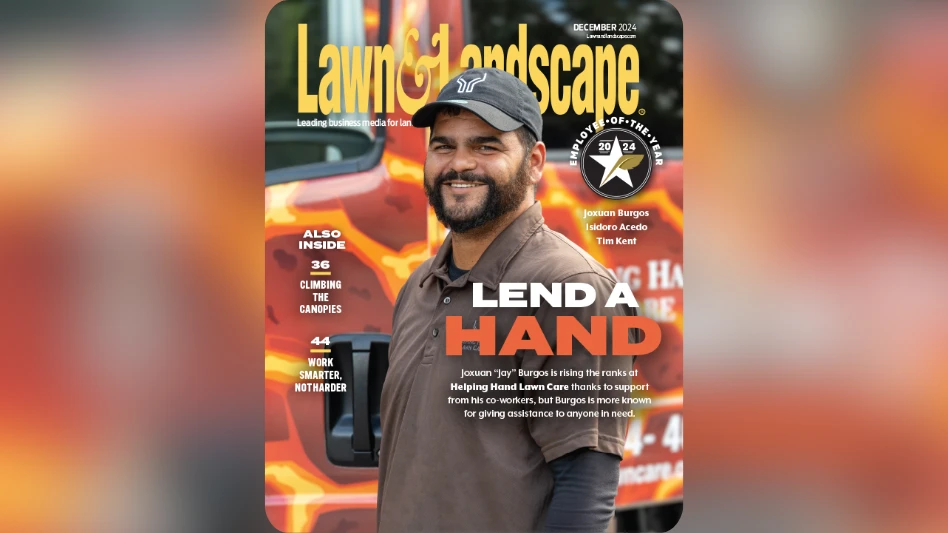
 Stark has been with ValleyCrest for almost 40 years, and has no intentions of stopping. Stark has been with ValleyCrest for almost 40 years, and has no intentions of stopping. |
When most couples celebrate a 25th wedding anniversary, the husband can show his appreciation for his wife in a number of ways. You know, the stuff you see in commercials – jewelry, a getaway to an exotic island or some romantic surprise. But that wasn’t what Harry Stark bought his wife, Joan, for their 25th anniversary. He showered his wife with love through a reel mower.
“She wouldn’t let anybody else touch the mower because she didn’t think anyone in the family could mow as well as she did,” says Pam Stark, the couple’s daughter and vice president of customer satisfaction of ValleyCrest Landscape Cos.
With a mother who loved gardening, a father who was a grading contractor and a brother, Steve, who ended up with a Ph.D. in entomology, Stark had dirt in her veins. She chose to get her fix in the landscaping industry.
But that fix has turned into something much more. With almost 37 years at ValleyCrest, it’s no surprise that those who have worked with her all point to her passion for and knowledge of the industry as the focal point of what has made her a success.
“First and foremost, Pam has a real passion for plants,” says Judy Guido, who worked with Stark at ValleyCrest and is still friends with her. “Whether it’s in the work place or you are going to a business meeting and you are walking past a building … she has a love of plants and nature.”
And those that work with her feed off her passion for the green industry.
“Her level of enthusiasm just blows people away and it is 24 hours a day,” says, Roger Zino, CEO of ValleyCrest Landscape Cos. “It’s genuine. I wish the world was filled with people like Pam Stark.”
 Stark was ValleyCrest’s first female vice president. Stark was ValleyCrest’s first female vice president. |
But don’t get the wrong idea. Stark isn’t that annoying type of employee who has so much energy you just want them to go away. “It’s not the Energizer bunny energy,” Zino says. “She just cares about what she’s doing and wants to help people improve. She is unique.”
And even though Stark never married or had kids, she still has a nurturing touch. “My name for Pam,” Guido says, “has always been ‘Mother Nature.’ To me that depicts her.”
And getting back to Stark’s mother, she says mom and dad recently moved from their home, and as part of the sale, the reel mower stayed with the home. “I swear she shed more tears over that mower than she did leaving the house,” Stark laughs.
‘Bye’ the numbers. Work-ing with plants was part of Stark’s life at a young age, but her parents never pushed her to get involved in the industry. Even though her mother and grandmother were avid gardeners – and some of her fondest memories of her childhood were shopping for plants with her mother and working in the yard – she didn’t seek out a career in the green industry.
Instead, she wanted to focus on math, which wouldn’t have been a bad decision either for Stark. She took college level calculus in high school, and was certainly destined for a successful career in numbers. But that all changed when she paid a visit to Cal Poly, San Luis Obispo, and fell in the love with the campus, and a career path she didn’t know existed.
“That was the first time I understood there was a way to major in horticulture and agriculture,” she says.
But even then, it wasn’t landscaping that was her focus. Rather, she was heading into the nursery world.
“I was really into germinating and growing annual and perennial plants at that time, so that’s why I was thinking, maybe I’ll go into the nursery end of the business,” she says. “But, I took another serendipitous leap.”
Rookie hazing. Stark doesn’t remember why she jumped from nurseries to landscaping, but she can recall her first day on the job.
“It was just intimidating at the time because I was the only woman who showed up in the yard,” Stark says.
She wasn’t treated better or worse because she was a woman. Stark says she was treated fairly, and got the same hazing and grunt work that you’d expect for the new kid on the block.
“We went out to an office property and right by the front door, in the turf, was a gopher mound, and the gopher was damaging the look of the building,” she says.
So, her foreman had everyone else on the crew mow, while the foreman and Stark took care of the critter, which she wasn’t too concerned about at first. After all, there were pellets that you could just drop into a tunnel, and eventually, they would take care of the gopher.
 “And he gets a hose out and a shovel, which is the really brutal old fashioned way. And I think he wanted to get it done now as opposed to waiting for the gopher to find the pellets,” she says. “Luckily I got the hose end trying to flush the gopher out of the hole and (he) hit him over the head with a shovel. So I thought, great, this is the start to my job in the field.”
“And he gets a hose out and a shovel, which is the really brutal old fashioned way. And I think he wanted to get it done now as opposed to waiting for the gopher to find the pellets,” she says. “Luckily I got the hose end trying to flush the gopher out of the hole and (he) hit him over the head with a shovel. So I thought, great, this is the start to my job in the field.”
That same day, they went to a beautiful office project of high rise buildings that faced a courtyard filled with what seemed like hundreds of 10-by-10 squares of turf with little concrete walks between them. It would be Stark’s’ job to trim the edges … with a blade edger.
“I could do a blade edger straight along a pathway for a pretty long distance and be OK,” she says. “But when you have to make turn after turn after turn – I’m sure today they use a weed eater. But back then, we used blade edgers.”
Stark is sure the crew wondered if she would get fed up and quit. If any of them thought she’d head for the highway, and a new career choice, they were very, very wrong.
On her way up. Stark quickly worked her way up to foreman, which isn’t uncommon for a college graduate, but she still got funny looks from customers.
“Eventually, when I became a crew leader, and I remember, I’d have people stopping me on the job when I was working with a crew, because I worked right along with them, and they’d say, ‘Oh, this is interesting, is this your husband’s company’ or something like that,” she says. “I’d say, ‘No, this is my job and I chose to have it.’ So, that was actually the most challenging time. It took a couple of years for everybody to get it that I could pull my own weight, contribute and do a good job.”
Stark eventually became the first female branch manager in ValleyCrest history. And it was during this time that Zino learned a lesson from Stark.
Stark had just opened the company’s Palm Springs branch, and she had just a tough meeting with one of the branch’s main clients. This client – a big reason ValleyCrest had opened the branch in the first place – wasn’t happy and let Stark know it.
.jpg) Burton Sperber, who was also a magician, shows Stark a trick. Burton Sperber, who was also a magician, shows Stark a trick. |
“She was driving home and she said she realized ‘If this customer fires me, I don’t have a job, so, I better make sure the customer is satisfied,’” Zino says. “And I think that relatively simple story that says, ‘Hey guys, at the end of the day without our customers, none of us have jobs. So let’s figure out how to completely satisfy them.’
“It’s a very simple concept, but I would say when I think of Pam, I think of that story. And I can give that message out every week to people.”
And with that attitude, it’s no surprise Stark had the idea for and is now the vice president of customer satisfaction at ValleyCrest.
In a nutshell, Stark’s primary role is to make sure she gathers accurate customer feedback that is actionable and that will drive growth and improvement in the businesses because, in her words, “We exist because we have customers.”
But Andy Mandell, CEO of ValleyCrest Landscape Development, says it’s much more than that. He says Stark takes customer service to the next level and gets to the root of why someone cancelled and how they can avoid it in the future. But almost as important, she trains others to get the most out of the customers when it comes to their thoughts on ValleyCrest’s service.
“I describe Pam as our customer satisfaction evangelist,” he says. “She is really the person that keeps the energy and focus up on customer satisfaction.”
Striving for the best. Stark says early on in her life she was much more competitive than she is now.
“I used to do 100-mile bike races, small triathlons and water ski and snow ski,” she says. “I’m always outdoors.
“It was competitive when I was younger – I like the challenge and the thrill. But then later in life, it was just more fun.”
While that competitive drive has mellowed, the passion hasn’t for all things green. “I’ve literally been married to my job, especially in the early days, and then kind of just got used to it,” she says. “Even though I don’t have kids, I have a ton of plants and that’s my hobby, my passion, and I’m very proud of them.”
But it’s not just zeal and style that separates Stark from the pack. It’s substance: Guido remembers riding in a van with ValleyCrest founder, the late Burton S. Sperber, and Stark.
With Stark out of earshot, Sperber said Stark was the most-talented horticulturist he’d ever met.
“And coming from him,” Guido says, “those are huge accolades.”
No end in sight. Stark doesn’t have any plans to retire in the near future, or change her position.
But when she does decide to hang it up, she would love to volunteer somewhere – surprise, surprise – in the green industry.
“When I retire I intend to volunteer at a couple of botanic gardens,” she says.
But has she ever thought about what her life would be like working outside of the green industry?
“No, never,” she says. “I like to say we make the world a better place to be – to live, to work, to play. From the growing side of the industry, to the construction to the maintenance, the industry does great things for the Earth.”

The author is an associate editor at Lawn & Landscape. He can be reached at bhorn@gie.net.

Explore the March 2012 Issue
Check out more from this issue and find your next story to read.
Latest from Lawn & Landscape
- Senske acquires 2 Nutri-Lawn franchise operations in Canada
- Our Holiday Lighting Contest rolls on
- LawnPro Partners acquires Ohio's Meehan’s Lawn Service
- Landscape Workshop acquires 2 companies in Florida
- How to use ChatGPT to enhance daily operations
- NCNLA names Oskey as executive vice president
- Wise and willing
- Case provides Metallica's James Hetfield his specially designed CTL





